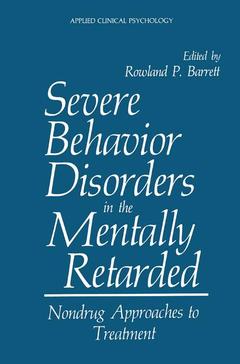Description
Severe Behavior Disorders in the Mentally Retarded, Softcover reprint of the original 1st ed. 1986
Nondrug Approaches to Treatment
NATO Science Series B: Series
Coordinator: Barrett Rowland P.
Language: English
Subject for Severe Behavior Disorders in the Mentally Retarded:
Keywords
Counseling; Training; behavior; pharmacotherapy; reinforcement
Publication date: 06-2013
404 p. · 15.5x23.5 cm · Paperback
404 p. · 15.5x23.5 cm · Paperback
Description
/li>Contents
/li>
It is well known that behavior problems are a salient characteristic of children and adults with mental retardation. That is not to say that all persons with mental retardation experience behavior disorders; how ever, most studies indicate that the incidence of emotional disturbance in this population is four to six times greater than that observed in similar intellectually nonhandicapped children and adults. It is equally well known that the principal form of treatment accorded clients with mental retardation and behavior disorders is pharmacotherapy or the prescrip tion of behavior modifying drugs. Recent studies show that 6 out of every 10 individuals with mental retardation have been prescribed drugs as treatment for disorders of emotion or behavior. Unfortunately, further studies indicate that only one or 2 out of every 10 clients receiving medication are determined to be "responders," such that some thera peutic benefit is derived from their drug treatment. As noted by the title, the single major thrust of this volume is to review approaches to the treatment of behavior disorders in persons with mental retardation from a nondrug perspective. This requires the presentation of a wide range of material on treatment: basic behavior modification programming, cognitive-behavioral strategies, habilitative approaches, counseling and psychotherapy, designing therapeutic living environments, managing medical factors bearing relevance to emotional illness, intervening with families, training special education teachers and direct care staff, and supplying information on the client's rights to obtain treatment in the least restrictive and least intrusive manner.
1 Behavior Modification: Reinforcement.- 2 Behavior Modification: Punishment.- 3 Behavior Modification: Self-Control and Cognitive Procedures.- 4 Habilitation Programs.- 5 Ecobehavioral Design: Programming for Engagement.- 6 Assessing and Managing Medical Factors.- 7 Counseling and Psychotherapy.- 8 Parent and Family Training.- 9 Teacher and School Personnel Training.- 10 Direct Care Staff Training.- 11 Strategies for Evaluating Treatment Effectiveness.- 12 Administrative Considerations and Responsibilities: Legal and Ethical Issues.
© 2024 LAVOISIER S.A.S.




